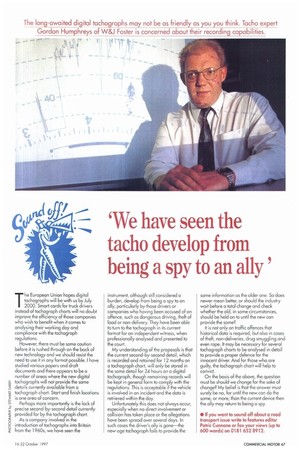'We have seen the tacho develop from being a spy to an ally'
Page 59

If you've noticed an error in this article please click here to report it so we can fix it.
The European Union hopes digital tachographs will be with us by July 2000. Smart cards for truck drivers instead of tachograph charts will no doubt improve the efficiency of those companies who wish to benefit when it comes to analysing their working day and compliance with the tachograph regulations.
However, there must be some caution before it is rushed through on the back of new technology and we should resist the need to use it in any format possible. I have studied various papers and draft documents and there appears to be a number of areas where the new digital tachographs will not provide the same details currently available from a tachograph chart. Start and finish locations is one area of concern.
Perhaps more importantly is the lack of precise second-by-second detail currently provided for by the tachograph chart. As a company involved in the introduction of tachographs into Britain from the 1960s, we have seen the instrument, although still considered a burden, develop from being a spy to an ally, particularly by those drivers or companies who having been accused of an offence, such as dangerous driving, theft of load or non-delivery. They have been able to turn to the tachograph in its current Format for an independent witness, when professionally analysed and presented to the court.
My understanding of the proposals is that the current second-by-second detail, which is recorded and retained for 12 months on a tachograph chart, will only be stored in the same detail for 24 hours on a digital tachograph, though remaining records will be kept in general form to comply with the regulations. This is acceptable if the vehicle is involved in an incident and the data is retrieved within the day. Unfortunately this does not always occur, especially when no direct involvement or collision has taken place or the allegations have been spread over several days. In such cases the driver's ally is gone—the new-age tachograph fails to provide the same information as the older one. So does newer mean better, or should the industry wait before a total change and check whether the old, in some circumstances, should be held on to until the new can provide the same?
It is not only on traffic offences that historical data is required, but also in cases of theft, non-deliveries, drug smuggling and even rape. It may be necessary for several tachograph charts to be analysed in detail to provide a proper defence or the innocent driver. And for those who are guilty, the tachograph chart will help to convict.
On the basis of the above, the question must be should we change for the sake of change? My belief is that the answer must surely be no, for until the new can do the same, or more, than the current device then the ally may return to being a spy.




















































































































